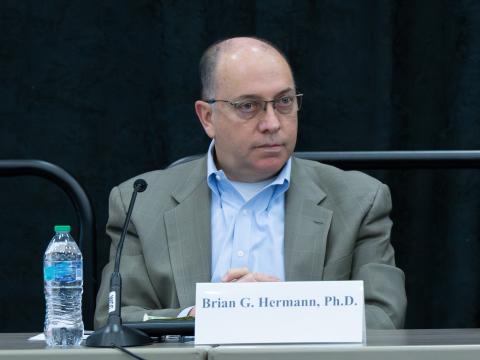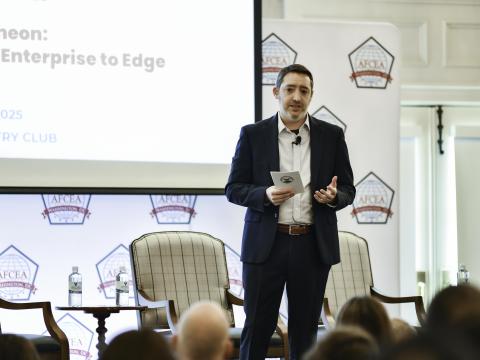Avionics Keys Successful Growth Strategy
Company value grows with strong acquisitions.
Combining alpine skiing with avionics may not be a standard formula for business success except to Brad Lawrence. The 64-year-old avionics executive is pursuing an aggressive business model that fits with his personal recreational philosophy as he takes his high-technology company forward in an era of tighter defense budgets. Based in the Seattle suburb of Bellevue, Lawrence’s Esterline Technologies Corporation is at the forefront of broad new economic imperatives reshaping defense contractors in this time of shifting Pentagon funding priorities.
Esterline is a fast-growing concern with a history of successful mergers that have helped it increase roughly fivefold in size, based on assets, and tripled net sales in about a decade. Wall Street seems to have applauded the moves and the strategy behind them. Esterline’s stock recently traded at about $75 a share even though it is a mid-tier company with a market cap of about $2 billion. And yet, its stock commands roughly the same price as one of its prime customers, the Boeing Company, an aerospace behemoth with a market cap 25 times larger. At press time, Esterline’s stock traded at only a slight discount to defense giants United Technologies and General Dynamics while commanding a premium over those of Raytheon and Northrop Grumman. An earnings juggernaut, Esterline has returned 40 percent to shareholders in the past year, dwarfing the stock profits of those five larger companies combined.
To many observers, Esterline would appear to have come out of nowhere. But Lawrence, the chief executive officer (CEO) of Esterline, says the firm actually is following a carefully laid out track. A decade ago, former Esterline CEO Robert W. Cremin unveiled a strategic plan to make the 43-year-old avionics firm a respected mid-cap concern. “I would love to take credit for our growth plan,” Lawrence says. “But that really wouldn’t be true. It was my predecessor’s idea. Of course, I concurred with the plan and have supported it every step of the way.”
A native of western Pennsylvania, Lawrence joined Esterline in 2002 and became chief executive in June 2009. A former executive at Rockwell International, Paccar and Flow International, Lawrence has a master’s degree in business administration from the University of Pittsburgh.
For all his focus on high-technology business strategy, Lawrence also keeps daydreaming about winter. He looks forward to a big storm that dumps deep, powdery snow all over the rugged mountains of the western United States. For the last several months, he has been salivating over a new pair of high-performance downhill snow skis he simply must have.
Underscoring their aggressive nature, these skis have a bold—and some might say jarring—color-and-graphics scheme. This entails bright green with futuristic computer-generated renderings of angular, almost high-technology-looking mountaintops. Lawrence acknowledges that not everyone will like the looks of these Atomic Access skis.
But, no matter, he says. It is the performance that counts. Lawrence has skied for decades and raved about these skis. With a pair of Access under his feet, he has had no trouble conquering whatever terrain he encountered as he went sailing off the main groomed runs for challenging back-country thrills. “I tried a demo pair at Big Sky,” the world-renowned Montana resort, Lawrence says. “I’ve never skied anything like them. Maneuvering them was almost effortless. They can handle anything.” At the end of the day the demo shop “practically had to pry them off my feet,” he says. “Unfortunately, there were none for sale. They were all out. I can’t wait until next season. I’m all psyched up.”
Of course, as a savvy defense industry executive with lots of technology experience, Lawrence could not resist making a prediction about the huge impact he sees for this class of skis. He says the so-called “rockers,” which take the concept of flex in the middle and turn it upside down, glide so smoothly they will transform the entire industry.
And Lawrence knows a lot about transformational change. Asked how Esterline will cope with defense budget cuts being hammered out in Washington, D.C., Lawrence shrugs off concerns. No matter how it all shakes out in the nation’s capital, he says, he sees a bright future for his company.
“We’re not shying away from defense at all,” he declares. “As a matter of fact, we had our second best year ever during the recession, when aerospace companies were hard hit, because we had defense to fall back on.
“Even after the proposed cuts, you’re still looking at a budget of $500 billion to $700 billion a year. You have to be careful, but we still see plenty of long-term opportunity there.”
For its part, Esterline was founded in the early stages of the Vietnam War when aircraft production ran at full throttle. Military clients clamored for avionics, and Esterline also has built a thriving electronics business by offering secure communications and a wide range of sensors. The company also operates an advanced materials unit that includes combustible ordnance and electronic warfare countermeasures. Energy, gaming and medical units round out the enterprise.
Defense and space customers account for roughly 40 percent of sales, as do commercial aerospace clients. Industrial applications bring in the remaining 20 percent of revenues. The company maintains a diversified client mix—no single client accounts for more than five percent of sales.
Acquisition has been a major part of the company’s growth. Over the years, Esterline has racked up a substantial portfolio of acquired companies. In all, it has purchased some 30 firms or product lines, making nine acquisitions in the past seven years alone. Clearly, growth through mergers remains a key piece of the strategy. But Lawrence says the company is extremely picky in choosing takeover candidates.
“We don’t buy early-stage companies,” he explains. “We don’t buy fixer-uppers. We don’t think we are smart enough to fix broken companies.
“But believe it or not, we take our organic [internal] growth more seriously,” he continues. “Our bottom line is growing faster than the top line. We view our balance sheet as a strategic asset.”
Esterline’s headquarters staff and the heads of divisions scattered around the world focus on making a smooth transition when the transaction occurs. They do not want to lose critical new staff because of a culture clash.
“We realize that, when you buy a company, the talented people have options,” he explains. “We want to make sure we give them a feeling of security here at Esterline. At the very least, we don’t want to do anything to make them feel insecure.”
In the most recent acquisition in early January, Esterline paid $120 million to acquire a privately held intelligence systems company, Eclipse Electronic Systems. Lawrence bought Eclipse to bolster sales in the intelligence, surveillance and reconnaissance markets. If history is any guide, Eclipse should make a great fit. To date, all of Esterline’s mergers have become success stories. Each broke even and began to add new earnings to the combined enterprise within a year of closing the deal, Lawrence says.
Chalk it up to what must be one of the more elaborate merger strategies in the industry. This is not growth for growth’s sake. The heads of the individual businesses are supposed to keep a radar screen of companies that would make a good strategic fit.
At the same time, a senior Esterline executive manages relationships with smaller firms that also seem like promising candidates, talking with them at air shows and trade events. It usually takes several years, perhaps as much as a decade, before Esterline feels the time is right to offer to buy the smaller company.
Often, the marriage occurs because the target company’s founder feels that he or she has reached a plateau and needs the money and infrastructure of a well-financed parent company to move forward. And Esterline has plenty of cash for growth—some $331 million of it on hand for the fiscal 2011 first quarter that ended January 28. During the period, company earnings rose 10 times faster than revenues, up a stunning 130 percent to nearly $30 million on a 10.6 percent sales increase.
Lawrence seems to relish the role of CEO of a company that is lean, profitable and making waves in the industry. But he certainly does not seem all business. He can shift effortlessly from talking about defense electronics sales and industry trends to how important it is in life to have fun—witness his outlook on skiing.
Then again, it was a thirst for excitement that led him to the aerospace industry in the first place. He recalls trudging across a snow-covered Pennsylvania campus one day and having an epiphany. The hit 1960s Mamas and the Papas song “California Dreamin’” played in his head. He recalls deciding right then to move to the West Coast. He later relocated to Newport Beach, a coastal community in Southern California where he played beach volleyball—that is, when he was not up in the mountains skiing.
“I try to stay active,” he says. “As many weekends as possible I play golf or go skiing, depending on the season. I think it’s important for CEOs to maintain a healthy work-life balance.”




Comments